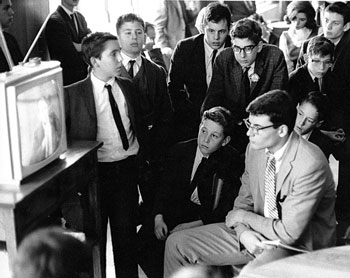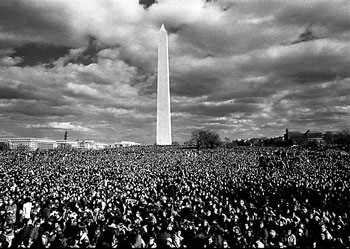 |
→ October 2006 Contents → Feature
|
"I and Eye":
Peter Simon October 2006
|
 |
||||||||||||
|
One of the most important times in a photographer's career is the publication of a retrospective. Those who have produced a large volume of work generally possess good intuition for the appropriate moment to look backward instead of forward. Though it often coincides with retirement, a retrospective may instead serve as a profound, cathartic, and transformative experience that signals the rebirth of enthusiasm and a new stage of working life.
Such was the joy with which photographer Peter Simon anticipated the publication of his retrospective book, I and Eye: Pictures of My Generation (Bullfinch Press of Little, Brown and Company). To celebrate and publicize the release of his book, Simon had scheduled five television appearances on the day of publication, starting with "Good Morning America" and continuing throughout the day. Few photographers have the good fortune to publish a retrospective at all, but even fewer have had the kind of publication misfortune that Peter Simon had on that fateful day, September 11, 2001.
Because of the events of that tragic day, all of Simon's promotional appearances were cancelled and his book's release went completely unobserved by anyone who might ordinarily have paid attention, given notice, or delivered kudos to the photographer. The events of September 11 dominated the news in print and standard TV programming completely, and it was weeks before regular scheduling returned to the networks. For Peter Simon, September 11 was a moment when his grief over lives lost and horror about the events of that day were compounded by a deeply personal loss as well -- the obliteration of one of the most anticipated and important moments in his own life. Five years later, The Digital Journalist would like to pay a belated tribute to I and Eye, with the hope that this book will take its place as the important retrospective work that it is.
Peter Simon's involvement with photography spans more than 40 years. I and Eye covers the development and progression of his life and career in photojournalism, the two of which are often indistinguishable and synthesized into what he calls, "participatory journalism." Born in New York City into a life of privilege, he describes not only the advantages granted him by birth but also the difficulty early on of finding his niche in an extraordinary family. His mother was loving, supportive, and charity-minded; his father, famous and hard-working (he was publishing mogul Richard Simon, of Simon & Schuster). Peter found himself insecure and struggling as the awkward, only boy with three older, talented, accomplished and dauntingly beautiful sisters. Luckily, Peter's father introduced him to the wonders of photography and the darkroom, and upon the elder Simon's death in 1960, Peter inherited not only his dad's Leica and Rollei cameras and darkroom equipment, but also his personal legacy at the tender age of twelve. Growing up with a powerful father who was absent much of the time, first due to work and later because of failing health, it was not until after his father's death that he began to see that photography brought him newfound esteem and great interest in the world around him. When he changed to a more creatively oriented school, he finally found that niche he'd been looking for as he began to express himself more seriously and more rewardingly through photography.
At the Riverdale Country School, young Simon flourished photographically, publishing his own mimeographed magazine, the R.C.S. Camera. Ray Penso, a slightly older high school friend, served as his mentor, introducing him to the work of Cartier-Bresson, Robert Frank and Harry Callahan. Penso wisely told him, "Your camera can be a vehicle for social commentary and change." At the age of 14, through the recommendation of family friend and photographer Philippe Halsman, Simon wrote an article for Popular Photographer, an event he describes as a big and very exciting breakthrough in his early career. One of his most memorable and still notable photographs, perhaps marking a path for his career as a socially conscious, participatory journalist, was of his high school classmates gathered around a television set in the Riverdale cafeteria to watch live coverage of the terrible news of President Kennedy's assassination in November 1963.
Two of Simon's musically talented sisters became professional musicians. The oldest, Joanna, chose opera, and Carly gained fame as a singer/songwriter in the world of popular music. In 1972, Carly married singer James Taylor, and Simon photographed them for the cover of Rolling Stone. He surprised them by showing up unexpectedly in Hawaii for their honeymoon. While there, he made some of his most memorable photographs ever, and even today speaks nostalgically about that time. Carly Simon Complete is a collection of Carly's sheet music to date (1975), an interview with her conducted by Simon, and his photographs of her through the years. Simon's involvement with the music world lasted decades, though he found he didn't like to pose shots — something that photographers like Annie Leibovitz did with a flair but Simon did reluctantly and with a grimace. Perhaps partly because of his disdain for orchestrated formality, he became especially fascinated by the natural world of Reggae music, traveling to Jamaica and photographing Bob Marley, Jimmy Cliff and others, and producing a book with collaborator Stephen Davis called Reggae Bloodlines.
Two other themes run through Peter Simon's life, and both have been well-documented by him over long periods of time. Baseball, he says, has always been in his blood, and so has Martha's Vineyard. From an early childhood attachment to the Dodgers and Ebbets Field to the later love of the "Miracle Mets," Simon has had a five-decade affair with baseball. His book with Jack Lang, The New York Mets, was published in 1987. Moving to Martha's Vineyard after Tree Frog, he lived on and off in the tiny town of Gay Head and found it convenient to travel to photograph elsewhere during the off-seasons. Simon has made the Vineyard his home more on than off since his marriage to Ronni, often splitting time between the Vineyard and New York, but always returning to where "it all makes sense." Later moving to Chilmark permanently with Ronni, he has developed a cottage industry of Vineyard photography, selling books, calendars and prints from his archives, and operating a booming family photo and special-events service. He has also documented his love affair with Martha's Vineyard in three books, On the Vineyard (1980), On the Vineyard II (1990), and On the Vineyard III (2000), and has several new book projects in the pipeline. Simon and Ronni have one son, Willie, who is 20 and in college in Vermont.
What I haven't mentioned yet is that Peter Simon's life, like so many of his contemporaries, has been full of ups and downs, bursting with advantages but also fraught with loss and disillusionment, with hopes countered by a good deal of despair. No wonder the baby boomer generation has sought the mysteries of enlightenment through countercultural experimentation and a fascination with Eastern religions and meditation. In spite of such a full range of experience, the greatest joy and achievement of Peter Simon's life to date, he says, has been overcoming the recent and most gloomy episode ever, when he descended into full-blown alcoholism after the earth-shattering events of September 11, 2001. The result of the attacks, paired with the anticlimactic publication of his retrospective I and Eye, overwhelmed and deeply depressed Simon. The anticipated success that became a non-event brought on a difficult struggle with addiction that almost cost him his marriage, his friends, and his health. I would venture to say that he has lived his life as a seeker of authenticity. His ability to accept what is before him but reject what does not resonate, combined with a deep sincerity and candor, may be the qualities that helped him win back his sobriety and emotional health. It is also his great good fortune to have the love of family and the courage to ask for help. In our interview with him, Peter Simon tells the fascinating story of his unique career and personal life, merged together in his medium of participatory journalism.
To buy "I And Eye" as well as other Peter Simon products, please visit his website at www.petersimon.com.
© Beverly Spicer
|
|||||||||||||
Back to October 2006 Contents
|
|



